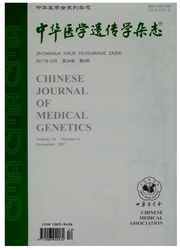

 中文摘要:
中文摘要:
目的对一例5q35缺失综合征胎儿进行产前诊断,探讨G显带联合微阵列比较基因组杂交技术(array comparative genomichybridization,aCGH)在产前诊断超声异常胎儿中的应用价值。方法应用常规G显带分析胎儿及其父母的染色体核型,应用aCGH技术分析胎儿及其父母的DNA拷贝数变异(copy nutuber variations,CNVs)并对核型分析结果进行精确定位。结果胎儿父母外周血染色体核型分析及aCGH分析结果均未见异常,胎儿核型为46,XY,t(5;io)(q35;p13);aCGH检测发现胎儿5号染色体存在1.68Mb的新发缺失,缺失区位于5q35.2q35.3,为5号染色体长臂缺失综合征,10号染色体存在1.44Mb的染色体重复,重复区位于10p14p13。结论aCGH技术具有更高的分辨率和准确性,是G显带核型分析的有益补充,可应用于临床分子细胞遗传诊断,特别是对缺失或者重复片段较小的非平衡易位患者的诊断中。
 英文摘要:
英文摘要:
Objective To use combined G-banding and array-comparative genomic (aCGH) for the prenatal diagnosis of a fetus with 5q35 deletion syndrome. Methods hybridization Chromosomal karotypes of the fetus and parents were analyzed with G-banding analysis, aCGH was performed to detect minor chromosomal structural abnormalities. Results The karyotype of the fetus was ascertained as 46, XY, t(5; 10) (q35; p13), and the karyotypes of the parents were normal, aCGH has identified a de novo 1.68 Mb deletion at 5q35.2q35.3 and a 1.44 Mb duplication at 10p14p13. Conclusion aCGH has a higher resolution and greater accuracy for mapping chromosomal aberrations and is a useful supplement for G banding karyptyping analysis
 同期刊论文项目
同期刊论文项目
 同项目期刊论文
同项目期刊论文
 期刊信息
期刊信息
